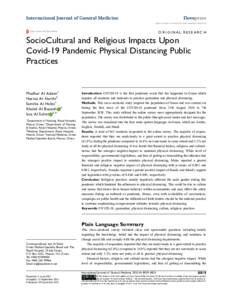وثيقة
Sociocultural and religious impacts upon COVID-19 pandemic physical distancing public practices.
المعرف
DOI: 10.2147/IJGM.S323318
المصدر
International Journal of General Medicine. v. 14, p. 8819-8831
المساهمون
Al-Harthiyah, Hasina., مؤلف
Al-Habsiyah, Samiha., مؤلف
Al-Busaidi, Khalid., مؤلف
Al-Salmi, Issa., مؤلف
الدولة
England.
مكان النشر
Massachusetts
الناشر
Dove Medical Press Ltd.
ميلادي
2021-01-01
اللغة
الأنجليزية
الملخص الإنجليزي
Introduction: COVID-19 is the first pandemic event that has happened in Oman which requires all residents and nationals to practice quarantine and physical distancing. Methods: This cross-sectional study targeted the population of Oman and was carried out during the first wave of the COVID-19 pandemic from 11th August 2020 to 7th September 2020. This study utilized the online survey most appropriately designed for the population. The survey was distributed to the public through social media and text messages. The survey was translated into the four main spoken languages in Oman, which are Arabic, English, Swahili, and Hindi. Results: A total of 943 residents responded to the online survey. The majority of respondents reported that they are ready/ready to a great extent to practice physical distancing (61.9%) during the pandemic compared to 34.9% not sure/ready to some extent and 3.2% not ready at all for physical distancing. It was found that financial factors, religious and cultural-norms had the strongest negative-impact to maintain physical distancing. While level of responsibility, governmental legislations, and fear of getting or transmitting the infection had the strongest positive impact to maintain physical distancing. Males reported a greater financial and religious negative impact of physical distancing with p-values of 0.002 and 0.001, respectively. Females reported a greater positive impact of family and friend's support and legislation with p-values of 0.046 and 0.008, respectively. Conclusion: Religious practices mainly negatively affected the male gender during this pandemic which hindered the adherence to physical distancing. This could be due to culture and norms that derive from human behavior within communities and may affect the safety measures during an outbreak or pandemic. Hence, even with availability of vaccinations, campaigns on public health and the utilization of faith leaders should be the national practice to continue emphasizing compassionate attitudes towards physical distancing.
ISSN
1178-7074
قالب العنصر
مقالات الدوريات

